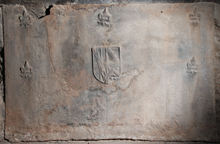-
1038
Description: Canted rectangular shape; edging formed of lengths of cross-cut dowel (top and sides); inscription across upper centre probably formed of thumb prints; the last digit of the date may be an incomplete 5 rotated left.
Notes: A crudely executed fireback; the cross-cut dowel used for the edging has not been noted on any other fireback.
Inscription: 16 wo 15[?]
- Decoration tags:
- rectangular with canted top corners (shape)
- cross-cut dowel (edging)
- simple stamps
- individual letters
- individual numbers
- text
Manufactured: in the early-17th century in the Weald area of England.
Current location: Herstmonceux Castle, Herstmonceux, East Sussex, England.
- Attached to series:
- Date & initials firebacks
-
1271
Description: Rectangular shape; twisted rope edging (top and sides only); central initials, WS, in different character sets, between split date, also in different numeral sets, with a rectangular floral patera repeated at each end; below, and at a slight incline to the right, a horizontal twisted rope dividing the plate. The '5' of the date has been stamped in reverse.
Notes: A boldly cast fireback with disparate character styles. Probably acquired for the castle in the early-20th century during its refurbishment for Edward Hudson by Edwin Lutyens.
Inscription: 1 6 W S 7 5 [5 reversed]
- Decoration tags:
- rectangular (shape)
- rope (edging)
- simple stamps
- carved stamps
- individual letters
- individual numbers
- text
- plants
Manufactured: in 1675 in England.
Current location: Lindisfarne Castle, Holy Island, Northumberland, England.
Museum number: 511616 (part of the National Trust museum group)
- Attached to series:
- Miscellaneous stamp firebacks
-
951
Description: Rectangular; central shield; fleur-de-lys stamp repeated three times across top and once on each side level with shield, all regularly spaced.
Notes: It is likely that the arms relate to the marriage, in 1541, of Christopher Sackville (c.1519-1559), son of John Sackville of Chiddingly, Sussex, and Constance Colepeper, daughter of Thomas Colepeper of Bedgebury, Kent, one of whose ancestors was the heiress, Elizabeth Hardreshull. The blazon: Sackville - quarterly or and gules, a bend vair; Colepeper - argent a bend engrailed gules; Hardreshull - argent a chevron sable between nine martlets gules, six and three. Christopher Sackville's brother, Sir Richard, owned Horsted Keynes furnace, which may have been where this fireback was cast. A candidate for the earliest English fireback with an example of personal arms.
Arms: Sackville impaling Colepeper and Hardreshall
- Decoration tags:
- rectangular (shape)
- none (edging)
- carved stamps
- heraldic
- armorial
Manufactured: in the mid-16th century possibly at Horsted Keynes Furnace in the Weald area of England.
Current location: in private hands, Horsted Keynes, West Sussex, England.
- Attached to series:
- Personal armorial firebacks
- Sackville firebacks


